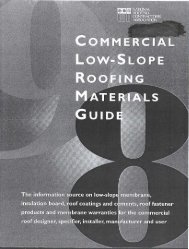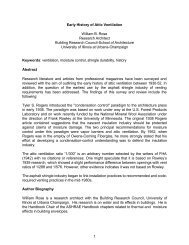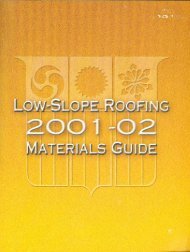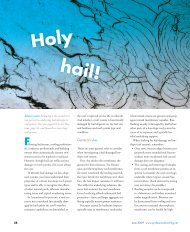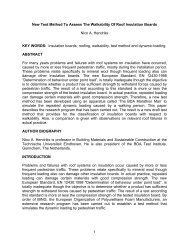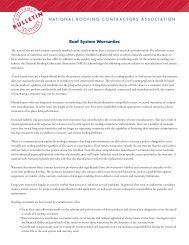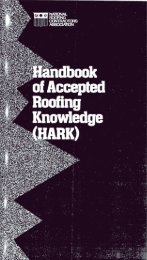1 Aging and Hail Research of PVC Membranes Frank J. Foley, Jim ...
1 Aging and Hail Research of PVC Membranes Frank J. Foley, Jim ...
1 Aging and Hail Research of PVC Membranes Frank J. Foley, Jim ...
Create successful ePaper yourself
Turn your PDF publications into a flip-book with our unique Google optimized e-Paper software.
From the 87 membrane samples, three analyses were made:1. Solvent extraction <strong>of</strong> plasticizer content - hidden flap <strong>and</strong> exposed portion<strong>of</strong> the same membrane.2. Micrometer measurement <strong>of</strong> membrane thickness - hidden flap <strong>and</strong>exposed portion <strong>of</strong> the same membrane.3. <strong>Hail</strong> simulation testing <strong>of</strong> membrane panels.3.0 TEST PROCEDURESSolvent Extraction <strong>of</strong> Plasticizer ContentTo explore the relative rates <strong>of</strong> plasticizer loss among these four major manufacturers,plasticizer was solvent-extracted from both the hidden flap <strong>and</strong> from the exposedportion <strong>of</strong> the membrane. Solvent extraction follows ASTM D 3421 protocol. Theunderlying concept <strong>of</strong> solvent extraction is that a bath <strong>of</strong> aggressive solvent easilyseparates the liquid plasticizer from the polymer resin. The ASTM protocol defines thatthe average extraction is plus or minus 3.3% <strong>of</strong> a complete extraction <strong>of</strong> liquidplasticizer from the <strong>PVC</strong> membrane.Prior to extraction, the sample is weighed <strong>and</strong> then placed into a bath <strong>of</strong> solvent for adefined period <strong>of</strong> time where the plasticizer is drawn out <strong>of</strong> the sample. The bathedsample is allowed to air dry <strong>and</strong> is weighed a second time. At this point, the plasticizeritself is captured as a dilution into the liquid solvent. The reduction in weight <strong>of</strong> the postbathsample represents the amount <strong>of</strong> removed liquid plasticizer. (For additionalchemical analysis <strong>of</strong> the type <strong>of</strong> plasticizer, the solvent may be evaporated, leaving theplasticizer as a residue).By extracting plasticizer from both the hidden flap <strong>and</strong> the exposed portion <strong>of</strong> the samemembrane panel, measurements <strong>of</strong> plasticizer content in both the exposed <strong>and</strong> hiddenportions <strong>of</strong> the membrane can be made. The differences between these two contentsreflect the amount <strong>of</strong> plasticizer that migrated from the membrane as a result <strong>of</strong>exposed weathering. Two qualifications in this analysis are highlighted:1. Solvent extraction is only made from the top layer <strong>of</strong> the membrane.<strong>PVC</strong> ro<strong>of</strong>ing membranes are usually a composite <strong>of</strong> films above <strong>and</strong>below the fabric reinforcement. Mechanical separation was made <strong>of</strong> thefilm above the reinforcement <strong>and</strong> only the top film were analyzed forsolvent extraction. Since the top film withst<strong>and</strong>s direct sunlight <strong>and</strong>weathering, analysis only <strong>of</strong> the top film dramatically reveals theweathering effect <strong>of</strong> exposure.10




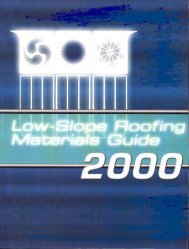
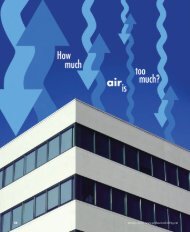
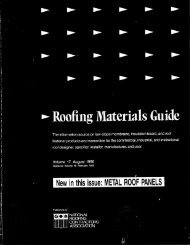
![Wm] - National Roofing Contractors Association](https://img.yumpu.com/36696816/1/190x245/wm-national-roofing-contractors-association.jpg?quality=85)

